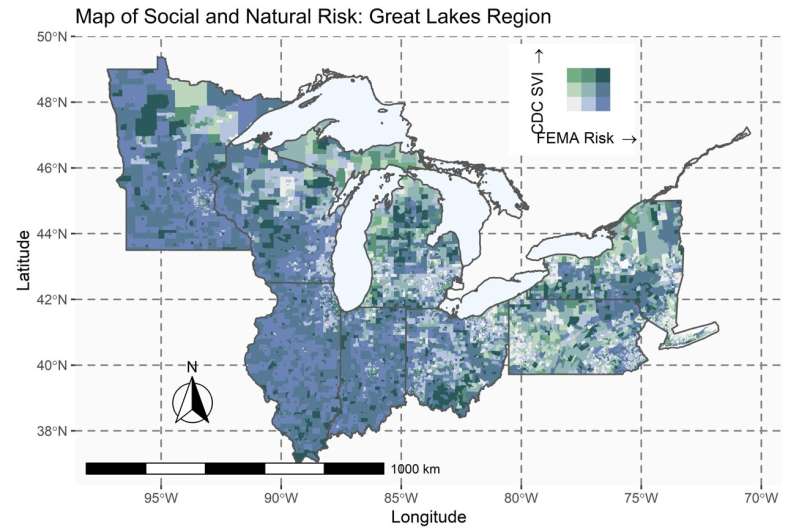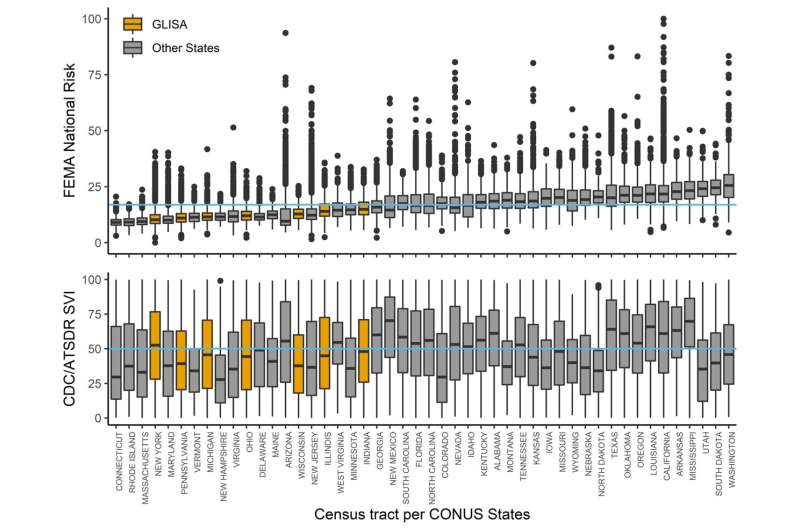Map of social and natural risk in the Great Lakes region, using data from the FEMA National Risk Index ranks and the CDC’s Social Vulnerability Index. Dark green represents high vulnerabilities in both FEMA risk and the social vulnerability index. Gray indicates low vulnerabilities for both. Blue indicates high FEMA risk, while green indicates a high social vulnerability index ranking. Credit: Earth's Future (2022). DOI: 10.1029/2022EF002942
Communities in the Great Lakes region need to start planning now for a future that may include "climate migrants" who leave behind increasingly frequent natural disasters in other parts of the country.
And user-friendly web-based tools can be a central part of that planning process.
Those are the main messages of a commentary published online Oct. 6 in Earth's Future by a University of Michigan geographer and several colleagues. The authors are developing web-based tools, such as interactive maps, that will enable residents, city planners, engineers, researchers and policymakers to envision various in-migration scenarios.
The goal is to better prepare for the future while improving conditions for current residents of the eight-state Great Lakes region.
"While we do not know if people will come, how many, who they might be and where they might settle, it is important that Great Lakes communities prepare and plan for a potential future that includes new residents," said Derek Van Berkel, assistant professor at the U-M School for Environment and Sustainability and lead author of the commentary.
"This is necessary to prevent further negative impacts on the current residents of cities that may already be living in conditions that are unequal, unjust and vulnerable to climate and environmental impact."
Last year, the World Bank estimated that some 200 million people worldwide may migrate in coming decades in response to stressors exacerbated by climate change. While climate-driven migration will undoubtedly be traumatic for the victims, a few U.S. communities—including Great Lakes coastal cities such as Duluth, Minnesota and Buffalo, New York—have openly wondered whether it might also be an opportunity.
Compared to the drought- and wildfire-ravaged U.S. West, the hurricane-susceptible Gulf of Mexico states and the sea level rise-exposed East and West coasts, the Great Lakes region may fare relatively well in the face of a changing climate—thanks in part to abundant fresh water and projected milder wintertime temperatures in the future, say Van Berkel and colleagues.
According to the Federal Emergency Management Agency's national risk index, most neighborhoods in the Great Lakes rank well below the national risk average for exposure to 18 natural hazards—from avalanches to volcanic activity and wildfires.
Top: The Federal Emergency Management Agency’s National Risk Index ranks total community exposure to 18 natural hazards: avalanche, coastal flooding, cold wave, drought, earthquake, hail, heat wave, hurricane, ice storm, landslide, lightning, riverine flooding, strong wind, tornado, tsunami, volcanic activity, wildfire, and winter weather. Census tracts in the Great Lakes region, which can roughly be described as neighborhoods, rank well below the national risk average (blue line). Bottom: The Center for Disease Control and Prevention’s Social Vulnerability Index ranking system combines 15 social factors including poverty, lack of vehicle access, and crowded housing to assess total social vulnerability per census tract. Great Lakes region neighborhoods are, on average—with the exception of New York—below the national social vulnerability average. Credit: Earth's Future (2022). DOI: 10.1029/2022EF002942
Most of the Great Lakes region (GLR) also scores below the national "social vulnerability average" for 15 social factors—including poverty, lack of vehicle access and crowded housing—evaluated by the Centers for Disease Control and Prevention.
"Given these apparently favorable environmental and social conditions, the tantalizing possibility that the GLR may experience renewed population growth relative to other U.S. regions has emerged as an important question that can critically affect how GLR urban communities prepare and plan for the future," according to the commentary authors.
However, understanding how such population shifts might affect current residents is essential if the region is to avoid exacerbating existing inequalities and climate vulnerabilities, the authors say.
With support from GLISA, the Great Lakes Integrated Science and Assessment project, Van Berkel and colleagues are developing web-based tools—formally known as a public participatory GIS system—to help residents, planners and researchers visualize various in-migration scenarios.
For example, they have combined the FEMA and CDC risk/vulnerability data into an interactive point-and-click regional map that allows users to zero in on individual census tracts. The web tools will be shared with the public by GLISA, which is a partnership between U-M and Michigan State University, supported by the National Oceanic and Atmospheric Administration.
"The public is becoming increasingly familiar with using this kind of interactive data through navigation tools like Google Maps," said Van Berkel, co-principal investigator on the project. "We are tapping into this geoliteracy to broaden and increase participation in these prioritization and planning endeavors."
The existing inequalities and climate vulnerabilities mentioned in the commentary include things like aging and poorly maintained infrastructure in Great Lakes cities such as Detroit, where increasingly frequent heavy rainstorms can cause flooding and community damages. Similarly, the lack of adequate city-cooling green space in some communities can amplify summer heat waves, which are expected to become increasingly common in the Great Lakes region.
"In many cities, historical socioeconomic disparities have deepened prevailing vulnerabilities to environmental hazards, as demonstrated by the Flint water contamination crisis," according to the commentary authors.
"Without careful recognition of how responses to migration might further exacerbate inequality and climate vulnerability affecting GLR urban communities, cities may move even farther from realizing a sustainable and just future for both current residents and future in-migrants," they wrote.
More information: Derek Van Berkel et al, Planning for Climate Migration in Great Lake Legacy Cities, Earth's Future (2022). DOI: 10.1029/2022EF002942
Journal information: Earth's Future
Provided by University of Michigan

























